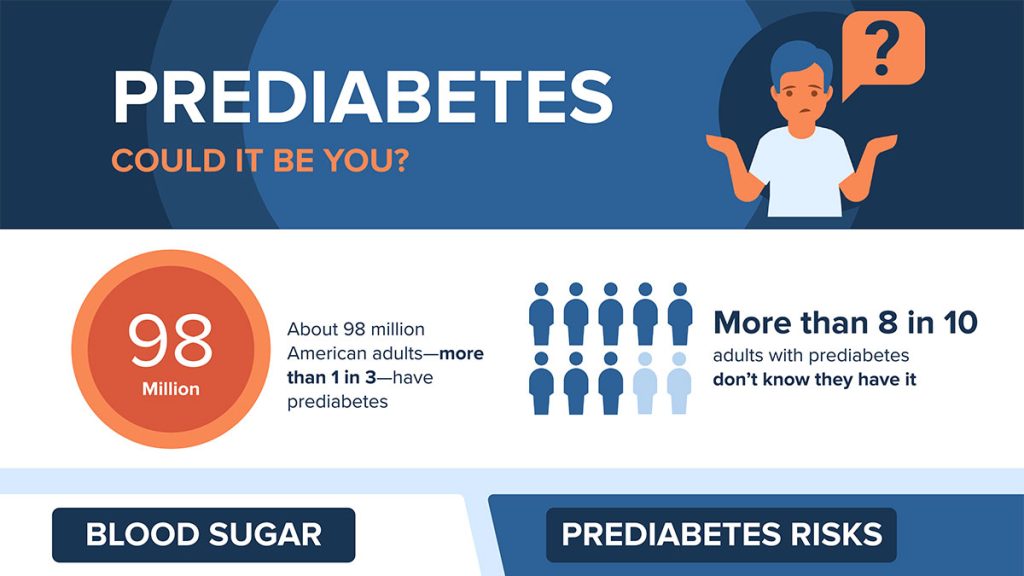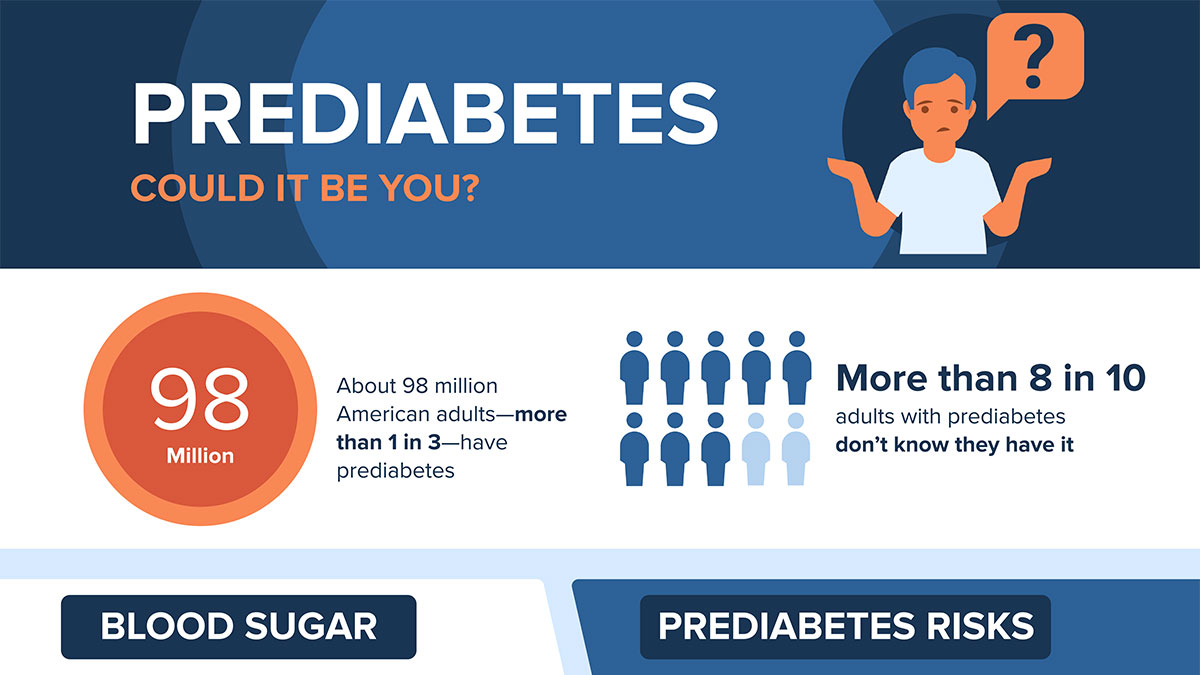If you’ve recently been told you have pre-diabetes, you’re not alone—and you’re not powerless. Over 96 million American adults have pre-diabetes, yet 80% don’t even know it, according to the CDC. The good news? With the right pre-diabetes patient education, you can reverse course and significantly lower your risk of developing type 2 diabetes. This guide is your trusted companion—clear, science-backed, and designed with your real-life needs in mind.
What Is Pre-Diabetes? (And Why Should You Care?)
Pre-diabetes means your blood sugar levels are higher than normal—but not yet high enough to be diagnosed as type 2 diabetes. It’s a warning sign, not a life sentence.
According to the American Diabetes Association (ADA), pre-diabetes is diagnosed when:
- Fasting blood glucose: 100–125 mg/dL
- HbA1c (average blood sugar over 2–3 months): 5.7%–6.4%
- Oral glucose tolerance test (2-hour): 140–199 mg/dL
Left unaddressed, up to 70% of people with pre-diabetes will develop type 2 diabetes. But here’s the empowering part: lifestyle changes can cut that risk by 58%, as shown in the landmark Diabetes Prevention Program (DPP) study.
💡 Expert Insight: “Pre-diabetes is your body’s wake-up call. It’s the perfect time to act—before permanent damage occurs,” says Dr. Robert Gabbay, Chief Scientific & Medical Officer at the ADA.
For more on how blood sugar works, see the Wikipedia entry on glucose metabolism .
How Is Pre-Diabetes Diagnosed?
Many people assume they’d “feel” pre-diabetes—but it often has no obvious symptoms. That’s why screening matters, especially if you:
- Are over 35
- Have a BMI ≥25
- Have a family history of diabetes
- Are physically inactive
- Have high blood pressure or PCOS
Your doctor may order one (or more) of these tests:
- Fasting Plasma Glucose (FPG) – after 8+ hours without food
- HbA1c Test – no fasting required; reflects 3-month average
- Oral Glucose Tolerance Test (OGTT) – drink a sugary solution, then test blood sugar after 2 hours
Tip: Ask for your actual numbers—not just “normal” or “abnormal.” Tracking trends helps you stay proactive.

Can Pre-Diabetes Be Reversed? (Spoiler: Yes!)
The short answer: Yes—through consistent, sustainable lifestyle changes. The DPP study proved that modest weight loss (5–7% of body weight) plus 150 minutes of weekly physical activity slashes diabetes risk dramatically.
Real-Life Success Story
Maria, 48, was diagnosed with pre-diabetes (HbA1c: 6.1%). She:
- Walked 30 minutes/day, 5 days/week
- Swapped sugary drinks for water or unsweetened tea
- Lost 12 pounds in 4 months
- Result: Her HbA1c dropped to 5.4%—back in the normal range.
5 Actionable Steps for Effective Pre-Diabetes Patient Education
Knowledge is power—but action creates results. Here’s your step-by-step plan:
1. Adopt a Balanced, Low-Glycemic Diet
Focus on foods that stabilize blood sugar:
- Non-starchy vegetables: spinach, broccoli, peppers
- Lean proteins: chicken, fish, tofu, legumes
- Healthy fats: avocado, nuts, olive oil
- Whole grains: quinoa, oats, brown rice (in moderation)
Avoid or limit:
❌ Sugary drinks (soda, juice)
❌ Refined carbs (white bread, pastries)
❌ Processed snacks (chips, cookies)
📊 Quick Comparison:
White bread 75 High spike Steel-cut oats 42 Gradual rise
2. Move Your Body—Consistently
Aim for 150 minutes/week of moderate activity (e.g., brisk walking). Break it into 30-minute sessions, 5 days a week. Even 10-minute walks after meals can lower post-meal glucose spikes by 20–30%.
3. Lose 5–7% of Your Body Weight
If you weigh 200 lbs, losing 10–14 pounds makes a measurable difference. Use portion control, mindful eating, and track progress with a food journal or app like MyFitnessPal.
4. Get Quality Sleep (7–9 Hours/Night)
Poor sleep disrupts insulin sensitivity. A 2022 study in Diabetologia found that adults sleeping <6 hours/night had a 40% higher risk of progressing to diabetes.
5. Monitor & Partner with Your Healthcare Team
- Get retested every 6–12 months
- Ask about CDC-recognized Diabetes Prevention Programs (DPP)—many are free or covered by insurance
- Consider working with a registered dietitian or certified diabetes care specialist
Common Myths About Pre-Diabetes—Busted!
| “Pre-diabetes isn’t serious.” | It increases risk of heart disease, stroke, and kidney damage—even before diabetes develops. |
| “Only overweight people get it.” | While weight is a factor, 15% of pre-diabetes cases occur in people with normal BMI. |
| “Medication is the best fix.” | Lifestyle changes aremore effectivethan metformin for most adults under 60 (per DPP data). |
FAQ: Your Pre-Diabetes Questions—Answered
Q: How often should I check my blood sugar if I have pre-diabetes?
A: Most people don’t need daily monitoring. Your doctor will likely recommend HbA1c tests every 6–12 months. Home glucose meters aren’t routinely advised unless you’re in a high-risk group or enrolled in a structured program.
Q: Can stress affect my pre-diabetes?
A: Yes. Chronic stress raises cortisol, which increases blood sugar. Practice stress-reduction techniques like deep breathing, yoga, or mindfulness—even 10 minutes daily helps.
Q: Is pre-diabetes genetic?
A: Family history increases risk, but genes aren’t destiny. Lifestyle plays a larger role. If your parent has type 2 diabetes, your risk doubles—but healthy habits can override that.
Q: What’s the difference between pre-diabetes and insulin resistance?
A: Insulin resistance (when cells don’t respond well to insulin) often causes pre-diabetes. Not everyone with insulin resistance has elevated blood sugar yet—but it’s usually the underlying mechanism.
Q: Can I still eat fruit?
A: Absolutely! Choose whole fruits (berries, apples, pears) over juice. Pair with protein or fat (e.g., apple + almond butter) to blunt sugar spikes.
Q: How quickly can I reverse pre-diabetes?
A: Many see improvement in 3–6 months with consistent changes. Full reversal (normal HbA1c) often happens within a year.
Conclusion: Take Control—Your Future Self Will Thank You
Pre-diabetes patient education isn’t just about avoiding a diagnosis—it’s about reclaiming energy, reducing health risks, and living your fullest life. You now have the tools: simple dietary swaps, manageable movement goals, and proven strategies backed by science.
You’ve got this. And you’re not alone—millions have walked this path and succeeded.
👉 Share this guide with someone who needs it! A quick post on Facebook or a text to a friend could be the nudge they need to take their first step toward better health.
Remember: Small changes, consistently applied, create big results.

Leave a Reply